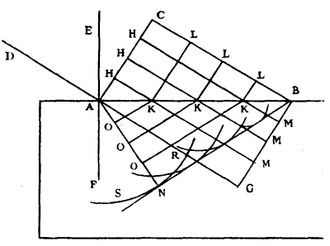Refraction
Links and useful resources
- START HERE: Physics 2024 class outline
- Physics classroom online interactive tools
- OpenSTAX high school physics
- NotebookLM physics notebook
- Physics projects
- AP Physics 1 Dan Fullerton videos
Lightning Round Questions
- (lang) What is a subordinate clause?
- What are zaibatsu? (powerful Japanese family business organizations that controlled whole sections of industry)
- What is the difference between an elastic collision and an inelastic collision?
- What is a control in an experiment? Why is it important?
- What does inheritance mean for object-oriented programming?
- If you double an object's momentum by increasing its velocity, what happens to its kinetic energy?
gr7: [lightning:: ]
gr10: [lightning:: ]
Concept summary and connections
- Refraction: When light passes through the boundary between different materials, it bends
- Light can also reflect or absorb when it hits a boundary between materials. Often, all three happen.
- Bending of light is what allows us to see and make optical instruments.
- Snell's law:
is the refractive index of the material, one for each side of the boundary is the angle that the light "ray" forms with the surface normal of the boundary. - The normal is a vector that is perpendicular to the surface (just like in 3D modeling)
Lesson content with examples
Wikipedia: Snell's Law
Wikipedia: Refraction
Refraction on youtube
Light bends when it crosses material boundaries, but why?? It happens because different materials change the speed of light that passe through them. Considering light as a wave, if you change its speed in a way that intercepts the wave at an angle to its direction of propagation, it ends up bending the wave. The diagram below was created by Christiaan Huygens in 1678, and it does a great job of illustrating what's happening:

Lenses work by making this bending happen over a curved surface, so that the wave is bent in a way that sends all of the motion toward (or away from) a specific focal point.
Snell's Law describes how this bending works: Light bends more when its angle is farther away from the normal to the surface. The relationship looks like this:
Where the
It turns out that the index of refraction is not the same for all colors of light, so when you get a number like
When light enters a material with a lower speed of light (a higher optical density and a greater index of refraction), it bends toward the normal going into the material. When it enters a material with a higher speed of light (lower optical density, lower index of refraction), it bends away from the normal pointing into that material.
One easy way to remember this is to use two rays of light that are close to each other. Pretend they are connected by a string or a ruler, going along parallel to each other. If the light hits the surface at an angle, one of the two will be first to hit. If it slows down, then the light bends toward the new material. If it speeds up, then the light has to bend the other way in order for them to stay connected. REMEMBER THE LAWN MOWER!!!!